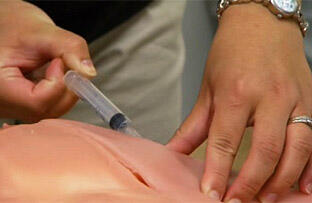May 5, 2009
See one, do one, teach one
Adage Gives Way to a New Trend: Simulation
Share this story
A 33-year-old male is brought to the emergency room complaining of severe stomach pains after an evening of partying with friends in a nearby corn field. He appears rather disoriented, mumbling over and over that he is “feeling sick.” The medical team assigned to his care quickly springs into action, asking him questions and checking his vitals. His pupils are dilated, his blood pressure is up and he begins to convulse.

“What next? What’s the diagnosis?” a voice behind them asks. They stop what they are doing and begin to discuss the next course of action.
In a true medical emergency, time is of the essence — but in this scenario, the “patient” is a fully wireless, portable patient simulator that closely mimics the anatomical workings of the human body. The team is a group of third-year medical students from the Virginia Commonwealth University School of Medicine.
In this setting, they have the luxury of time. They can talk through the clinical scenario, bounce ideas about diagnosis and treatment off each other and get important feedback about their performance or approach. Through hands-on simulation training, they have room to make mistakes and learn from them.
Those are just a few of the benefits of simulation training and the reason why in recent years it has become a growing trend in medical schools across the country. Simulation has added a new dimension to the adage in medicine, ‘See one, do one, teach one.’
“We know that adults learn best when they are challenged. They learn best, in a sense, from games where they have a complex situation and they have to navigate through it. It engages them and forces them to think,” said Alan Dow, M.D., assistant dean of clinical curriculum and assistant professor of internal medicine at the VCU School of Medicine.
“Here we can provide students with educational experiences that are not possible during the inner workings of a typical day,” he said.
During the week of April 28, the class of 163 third-year students participated in the School of Medicine’s Workshop Week. This was the first time simulation activities were included — in past years the schedule consisted of mainly lectures. The new VCU Center for Human Simulation and Patient Safety was the central location for much of the activity.
“At this point, the third-year students have learned the medical language and have had a lot of patient encounters. They’ve seen that medicine is not so black and white — there are a lot of shades of gray and lots of difficult situations,” Dow said. “Medicine is not an A, B, C or D multiple-choice test and the students really have to think through things and make some complicated decisions.”
The students were given the opportunity to hone their procedural, diagnostic and communication skills through four hands-on simulation activities.
Three of the four activities were stationed at the VCU Center for Human Simulation and Patient Safety, including placing central venous catheters; listening to the heart of a cardiopulmonary simulator called “Harvey” that realistically simulates 30 cardiac conditions; and diagnosing possible conditions for a simulator called iStan.
A fourth workshop focused on communication skills and included faculty from the theater department. Students and faculty were given the opportunity to role play and learn about their strengths and weakness in communication — a skill some critics believe many physicians do not do very well.
“I think that this year’s workshop week and working through the simulation center are examples of where we are headed in the future in medical education. It’s a chance for us to be innovative, try some new things, and think about medical training in a different way,” said Dow.
“Our goal is to take this form of training and continue to build it. We see we have some really exciting opportunities in medical training to make people better doctors; make them more effective at procedures, more effective communicators, more effective at making diagnoses. All these things are key for us as we look at our goals for the next generation of physicians,” said Dow.
Subscribe to VCU News
Subscribe to VCU News at newsletter.vcu.edu and receive a selection of stories, videos, photos, news clips and event listings in your inbox.







